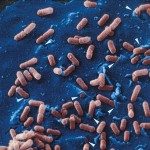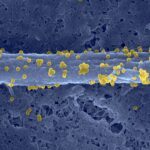Link to Pubmed [PMID] – 9393831
Infect Immun 1997 Dec; 65(12): 5309-19
Listeria monocytogenes can use two different surface proteins, internalin (InlA) and InlB, to invade mammalian cells. The exact role of these invasiveness factors in vivo remains to be determined. In cultured cells, InlA is necessary to promote Listeria entry into human epithelial cells, such as Caco-2 cells, whereas InlB is necessary to promote Listeria internalization in several other cell types, including hepatocytes, fibroblasts, and epithelioid cells, such as Vero, HeLa, CHO, or Hep-2 cells. We have recently reported that the InlA receptor on Caco-2 cells is the cell adhesion molecule E-cadherin and demonstrated that nonpermissive fibroblasts become permissive for internalin-mediated entry when transfected with the gene coding for LCAM, the chicken homolog of the human E-cadherin gene. In this study, we demonstrate for the first time that the internalin protein alone is sufficient to promote internalization into cells expressing its receptor. Indeed, internalin confers invasiveness to both Enterococcus faecalis and internalin-coated latex beads. As shown by transmission electron microscopy, these beads were phagocytosed via a “zipper” mechanism similar to that observed during the internalin-E-cadherin-mediated entry of Listeria. Moreover, a functional analysis of internalin demonstrates that its amino-terminal region, encompassing the leucine-rich repeat (LRR) region and the inter-repeat (IR) region, is necessary and sufficient to promote bacterial entry into cells expressing its receptor. Several lines of evidence suggest that the LRR region would interact directly with E-cadherin, whereas the IR region would be required for a proper folding of the LRR region.


